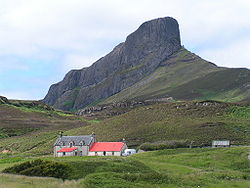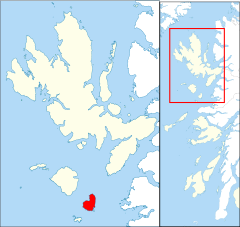Eigg: Difference between revisions
No edit summary |
No edit summary |
||
| Line 9: | Line 9: | ||
|latitude=56.9 | |latitude=56.9 | ||
|longitude=-6.15 | |longitude=-6.15 | ||
|map=Eigg - Skye and the Small Isles.svg | |||
|area=11¾ square miles | |area=11¾ square miles | ||
|highest point=[[An Sgurr (Eigg)|An Sgurr]], 1,289 feet | |highest point=[[An Sgurr (Eigg)|An Sgurr]], 1,289 feet | ||
Latest revision as of 22:57, 13 March 2020
| Eigg Gaelic: Eige | |
 An Sgurr, Eigg | |
|---|---|
| Main settlement: | Cleadale |
| Location | |
| Location: | 56°54’-0"N, 6°9’0"W |
| Grid reference: | NM476868 |
| Area: | 11¾ square miles |
| Highest point: | An Sgurr, 1,289 feet |
| Data | |
| Population: | 67 |
Eigg is one of the Small Isles, in the Inner Hebrides. It lies to the south of Skye and north of the Ardnamurchan peninsula. Eigg is part of Inverness-shire.
Eigg is five miles long from north to south, and three miles east to west. With an area of nearly 12 square miles, it is the largest of the Small Isles after Rum.
Its name is Gaelic, from eag, meaning "notched island".
Geography
The main settlement on Eigg is at Cleadale, a fertile coastal plain in the north-west. The isle is known for its quartz beach, called the "singing sands" (Tràigh a' Bhìgeil) on account of the squeaking noise it makes if walked on when dry.
The centre of the island is a moorland plateau, rising to 1,289 feet at An Sgurr, a dramatic stump of pitchstone, sheer on three sides. Walkers who complete the easy scramble to the top in good weather are rewarded with spectacular views all round, of Mull, Coll, Muck, the Outer Hebrides, Rum, Skye, and the mountains of Lochaber on mainland Great Britain.
History
Bronze Age and Iron Age inhabitants have left their mark on Eigg. The monastery at Kildonan was founded by a missionary possibly from either Dal Riata or an Irish Kingdom, St Donnan. He and his monks were massacred in 617 by the local Pictish queen. In the Middle Ages the island was held by Clan Donald.
Writing in 1549, Donald Munro, High Dean of the Isles wrote of "Egge" that it was:[1]
| “ | gude mayne land with ane paroch kirk in it, with mony solenne geis; very gude for store, namelie for scheip, with ane heavin for heiland Galayis | ” |
The Massacre Cave
During the sixteenth century there was a lengthy feud between the MacLeod and MacDonald clans, which may have led to the massacre of the island's entire population in the late 16th century. According to Clanranald tradition, in 1577 a party of MacLeods staying on the island became too amorous and caused trouble with the local girls. They were subsequently rounded up, bound and cast adrift in The Minch but were rescued by some clansmen.
A party of MacLeods subsequently landed on Eigg with revenge in mind. Their approach had been spotted by the islanders who had hidden in a secret cave called the Cave of Frances (Uamh Fhraing) on the south coast. The entrance to this cave was tiny and covered by moss, undergrowth and a small waterfall. After a thorough but fruitless search lasting for three to five days, the MacLeods set sail again but a MacDonald carelessly climbed onto a promontory to watch their departure and was spotted. The MacLeods returned and were able to follow his footprints back to the cave. The MacLeods then rerouted the source of the water, piled thatch and roof timbers at the cave entrance and set fire to it at the same time damping the flames so that the cave was filled with smoke thereby asphyxiating everyone inside either by smoke inhalation or heat and oxygen deprivation. Three hundred and ninety five people died in the cave, the whole population of the island bar one old lady who had not sought refuge there.
There are however some difficulties with this tale and in later times a minister of Eigg stated that "the less I enquired into its history... the more I was likely to feel I knew something about it".[2][3] Nonetheless, human remains in the cave were reported by Boswell in 1773, by Sir Walter Scott in 1814 and Hugh Miller in 1845. By 1854 they had been removed and buried elsewhere.[2][4]
The Massacre Cave (NM434874) sits in the back of a fault-like crevice under a steep rock face. It is no more than two feet high and one needs to crawl to gain access and then keep crawling for a further 23 ft before it opens out. The length is approximately 260 ft, the width 26 ft and height 20 ft.
18th and 19th centuries

Near to Massacre Cave there is another tidal cave with a large and visible entrance; it is high-roofed and is said to have been used for Roman Catholic services after the 1745 rebellion.
The geologist and writer Hugh Miller visited the island in the 1840s and wrote a long and detailed account of his explorations in his book The Cruise of the Betsey published in 1858. Miller was a self-taught geologist; so the book contains detailed observations of the geology of the island, including the Scuir and the singing sands. He describes the islanders of Eigg as "an active, middle-sized race, with well-developed heads, acute intellects, and singularly warm feelings". He describes seeing the bones of adults and children in family groups with the charred remains of their straw mattresses and small household objects still in Massacre Cave. Walter Scott was so appalled and moved on hearing that the skulls and bones of the dead were still stacked there, that he started a fund for a Christian burial which resulted in their removal.
By the 19th century, the island had a population of 500, producing potatoes, oats, cattle and kelp. When sheep farming became more profitable than any alternative, land was cleared by compulsory emigration - in 1853 the whole of the village of Gruilin, fourteen families, was forced to leave.
Isle of Eigg Heritage Trust

After decades of problems with absentee landlords in the 20th century, the island was bought in 1997 by the Isle of Eigg Heritage Trust, a partnership between the residents of Eigg, the council, and the Scottish Wildlife Trust. The story of this community buy-out is told in Alastair McIntosh's book Soil and Soul: People Versus Corporate Power published in 2001. At the time, the population was around 60. In 2012, Eigg has 90 residents, many of them young people who have returned to the island or who have moved there to make it their home and set up in business.
Economy and transport

Tourism is important to the local economy, especially in the summer months, and the first major project of the Heritage Trust was An Laimhrig, a new building near the jetty to house the island's shop and post office, Galmisadale Bay (café restaurant and bar) formerly known as Eigg Tearoom, craft shop and the toilet and shower facilities which are open 24 hours a day.[5] There are two ferry routes to the island. A'Nead Hand Knitwear is a new island business making garments such as cobweb shawls and scarves.[6]
There is a sheltered anchorage for boats at Galmisdale in the south of the island. In 2004 the old jetty there was extended to allow a roll-on roll-off ferry to dock.
Sustainability projects
In September 2008, Eigg began a year long series of projects as part of their success as one of ten finalists in the National Endowment for Science Technology and the Arts "Big Green Challenge". While the challenge finished in September 2009, the work to make the island "green" is continuing with solar water panels, alternative fuels, mass domestic insulation, transport and local food all being tackled.[7] In May 2009 the island hosted the "Giant's Footstep Family Festival", which included talks, workshops, music, theatre and advice about what individuals and communities can do to tackle climate change.[8]
In January 2010, Eigg was announced as one of three joint winners in NESTA's Big Green Challenge, winning a prize of £300,000. Eigg also won the prestigious UK Gold Award in July 2010.
Wildlife

An average of 130 species of bird are recorded annually. The island has breeding populations of various raptors: Golden Eagle, Buzzard, Peregrine Falcon, Kestrel, Hen Harrier and Short and Long-eared Owl. Great Northern Diver and Jack Snipe are winter visitors, and in summer Cuckoo, Whinchat, Whitethroat and Twite breed on the island.[9][10]
Outside links
- The island's website
- Geology of Eigg
- BBC Radio 4 - Open Country
- BBC Radio Scotland - Maggie Fyffe
- BBC Action Network - My story: Bringing power to the people
- Ashden Awards Case Study, video and photographs
- Book about the role of incomers on the island and photogallery
- The Cruise of the Betsey- Account of Miller's voyage
References
- ↑ a good land with a parish church and many gannets; very good for sheep, with a good harbour for Highland galleys": Munro, D. (1818) Description of the Western Isles of Scotland called Hybrides"
- ↑ 2.0 2.1 Banks (1977) pp. 56-67
- ↑ Kieran, Ben. Blood and Soil: A World History of Genocide and Extermination from Sparta to Darfur, Yale University Press, 2007 ISBN 0-300-10098-1, ISBN 978-0-300-10098-3.
- ↑ Lynn Forest-Hill, "Underground Man", Times Literary Supplement 14 January 2011 p. 15
- ↑ "Eigg Shop and Post Office" Isle of Eigg Heritage Trust. Retrieved 1 August 2009.
- ↑ "A'Nead Hand Knitwear" anead-knitwear.co.uk. Retrieved 1 August 2009.
- ↑ "Green Eigg islanders earn place in UK's Big Challenge says Press and Journal" islandsgoinggreen.org. Retrieved 23 September 2009.
- ↑ "Take Giant Green Footsteps to Eigg's Family Festival". Senscot. Retrieved 23 September 2009.
- ↑ "Eigg-ceptional summer". Scottish Wildlife (November 2007) No. 63 page 4.
- ↑ "Bird watching on Eigg" Isle of Eigg Heritage Trust. Retrieved 27 December 2007.
- Banks, Noel, (1977) Six Inner Hebrides. Newton Abbott: David & Charles. ISBN 0-7153-7368-4
